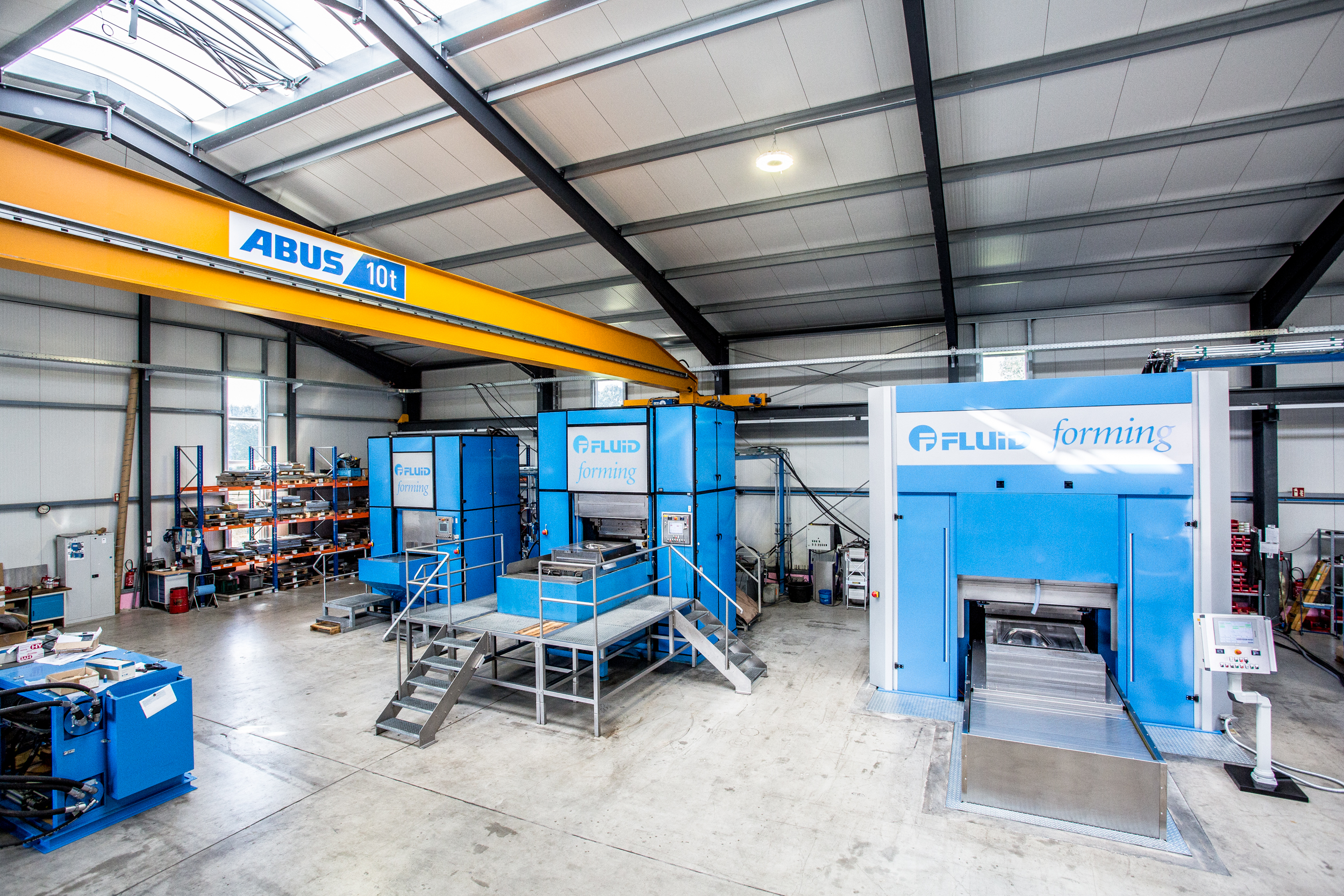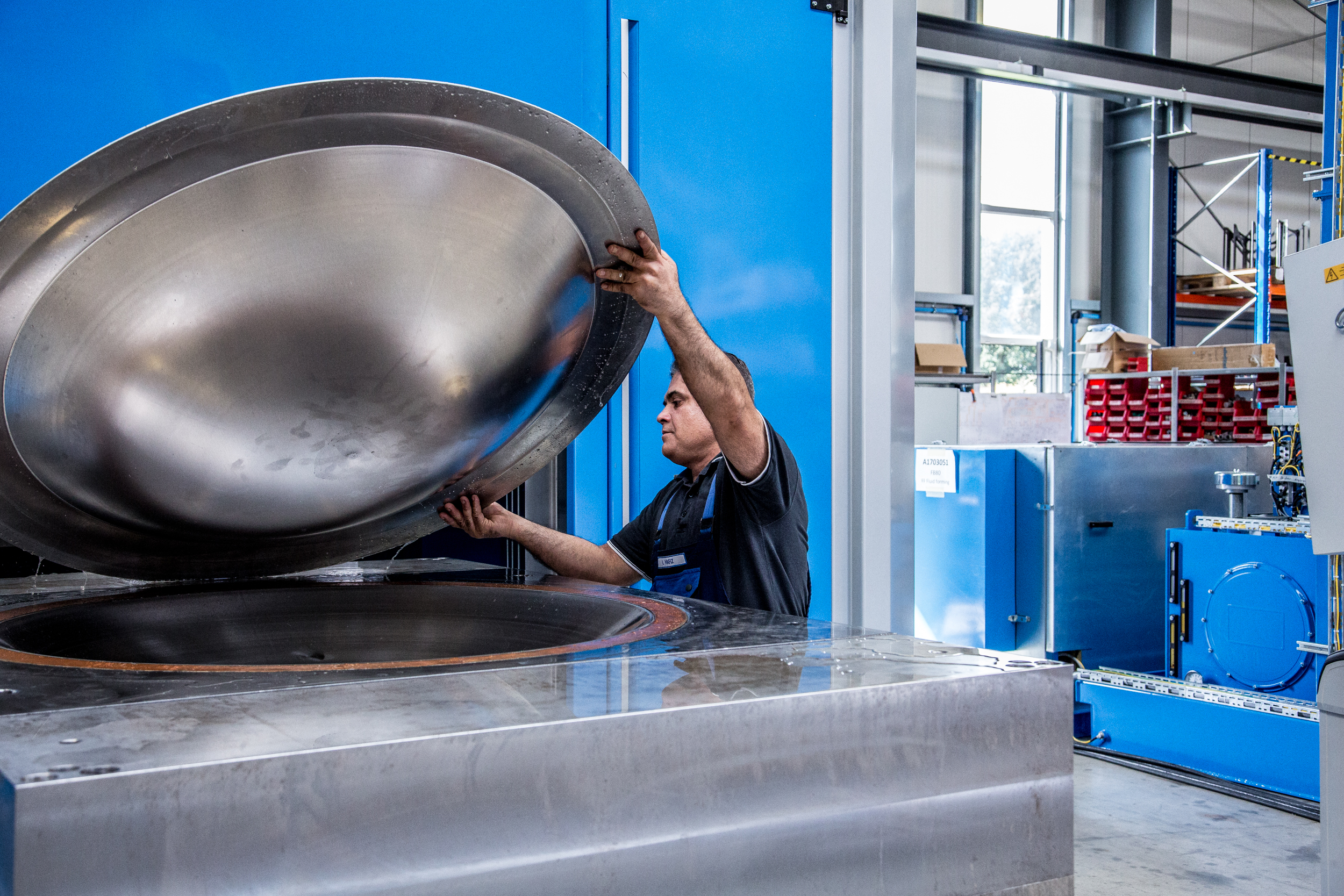Glossary
Sheet metal forming

Sheet metal forming is a subcategory of forming technology. It is characterized by the type of workpiece: In contrast to wire and solid forming, sheet metal forming only uses sheet metal. These sheets include all raw metal parts whose thickness is significantly less than the length and width. The flat pieces of metal can be processed using a variety of forming processes.
Overview
-
Basics of sheet metal forming
-
Sheet metal forming is important in these areas
-
The most common methods at a glance
-
Deep drawing as an example
-
Hydroforming: The innovative process offers these advantages
-
In-house solution or outsourcing
-
Frequently asked questions about sheet metal forming
Basics of sheet metal forming
When forming sheet metal, the same principles apply as for wire and bulk forming. Forming is based solely on the application of force – adding or subtracting material is not necessary with this technique. The mass remains the same, only the shape changes. With this approach, companies secure a number of advantages:
-
-
-
stress-oriented fiber flow
Sheet metal forming is important in these areas
-

Automotive industry
Sheet metal forming is used in the automotive industry to produce body parts such as doors, hoods, fenders and roofs.
-

Aerospace industry
In the aerospace industry, sheet metal forming is used to manufacture aircraft parts such as wings, fuselage panels and engine cases.
-

Electronics industry
Sheet metal forming is also used in the electronics industry to create housings for electronic devices such as computers, smartphones and tablets.
-

Medical device industry
In the medical device industry, sheet metal forming is used to manufacture housings, brackets, and other parts.
-

Household appliance industry
In the household appliance industry, sheet metal forming is used to manufacture housings and components for household appliances such as refrigerators, washing machines and dishwashers.
Sheet metal forming processes provide valuable services in numerous industrial sectors. This includes the automotive industry, which requires a wide range of formed components. Examples are fenders, doors and trunk lids. Parts shaped by sheet metal forming can also be found in large household appliances, furniture, sanitary facilities and cooking accessories. This applies, among other things, to housings, covers, extractor hoods, sinks and saucepans. Food cans are also the result of a forming process.
The most common methods at a glance
Numerous specific forming processes are possible for sheet metal forming. These procedures can be classified according to different criteria. For example, if the temperature is below the recrystallization temperature of the workpiece, it is cold forming. This variant is widespread when forming sheet metal, the alternatives hot forming and warm forming play a subordinate role.
In addition, the forming techniques for sheet metal can be subdivided according to the type of force applied. There are the following basic types of forming (prominent examples of the respective technique can be found in brackets):
-
Pressure forming (rolling, free forming)
-
Tension compression forming (deep drawing, drawing through, pressing)
-
Forming (lengths, depths, widths)
-
Shear forming (shifting, twisting)
-
Bending (free bending, die bending, roll bending)
Choosing the best sheet metal forming process depends on a number of factors. What is the sheet metal thickness of the raw part? How complex is the geometry of the desired workpiece? What requirements do companies place on surface quality? How quickly can the workpieces be produced? What are the costs? Engineers deal with these and other questions during the planning phase. Simulation programs provide valuable help in answering these questions. As part of the prototype construction, those responsible can specifically check whether the respective quality goals can be achieved.
In addition, the forming techniques for sheet metal can be subdivided according to the type of force applied. There are the following basic types of forming (prominent examples of the respective technique can be found in brackets):
Deep drawing as an example
A popular forming process is deep drawing as a sub-category of pull-compression forming. This technology is used, among other things, in the forming of car body parts. Deep drawing is an example of a huge number of forming techniques. This special form can be realized in three variants:
-
with forming tools such as stamps
-
with active media such as liquids
-
with active energy such as magnetic fields
Companies often use fixed tools in presses. Combinations with other forming processes are also widespread. A combination of stretch and deep drawing is suitable for large sheet metals, which are required in areas such as aircraft construction. Stretch forming has the advantage that large sheet metal can be processed with this process. But there is a lack of drawing depth. Manufacturers solve this problem with additional deep drawing.
Hydroforming: The innovative process offers these advantages
Hydroforming is also a modern technique in sheet metal forming, which has several advantages over deep drawing. Sheet metal hydroforming is a high-pressure forming process in which sheet metal blanks are given the desired shape using a fluid and high pressure. Companies prefer this process to deep drawing if they want to secure the following advantages:
-
-
-
Short development time of tools & prototypes
-
Complex geometries & modern design
As with all forming processes, the specific choice depends on the detailed requirement profile. The impressive repeat accuracy of hydroforming proves to be important, especially for complex components. Deviations can result in components being incompatible or not reliably performing their function. Manufacturing precision is a key criterion when choosing the process. In the case of products such as a cooking pot, minimal deviations can usually be tolerated: Many companies prefer other processes here.
In-house solution or outsourcing
As with all metal forming processes, the question arises as to whether manufacturers should use their own machines or outsource this production step. The fact that companies retain complete control over the production process and remain independent of suppliers speaks for in-house production. On the other hand, they need the appropriate machines and employees to operate these machines. If these forming machines have not been available up until now, companies have had to bear high investment costs. They also lose flexibility because they can only carry out certain forming processes with one machine. There are good reasons to leave sheet metal forming to specialists like FLUID forming.
Frequently asked questions about sheet metal forming
-
What is sheet metal forming?
In sheet metal forming, machines force flat sheet metal blanks into the desired shape. Only the shape of the sheet changes, the mass does not change in contrast to other processes such as chip-removing processes. The force can be applied by mechanical tools, liquids and air, among other things.
-
What forming processes are there?
Sheet metal can be formed using a variety of processes. Compressive, tensile compressive, tensile, shearing and bending techniques are possible. Common sheet metal forming processes are deep drawing, rolling and hydroforming. When choosing the ideal technology, numerous aspects such as the complexity of the desired geometry and the desired surface quality are of interest. The dimensions of the sheet metal blank to be processed also deserve attention.
-
How can you check whether a sheet metal is suitable for forming?
When it comes to suitability for forming, low strength and high elongation at break are particularly important. Depending on the forming process, other factors can also play a role. In practice, different test methods have been established for the various techniques.
-
Which materials can be formed with hydroforming?
Manufacturers use this type of sheet metal forming for aluminum, brass, steel, stainless steel and copper, among other things. Suppliers such as FLUID forming carry out a detailed feasibility analysis before processing the order – for this they use innovative simulation programs for sheet metal or solid forming.









